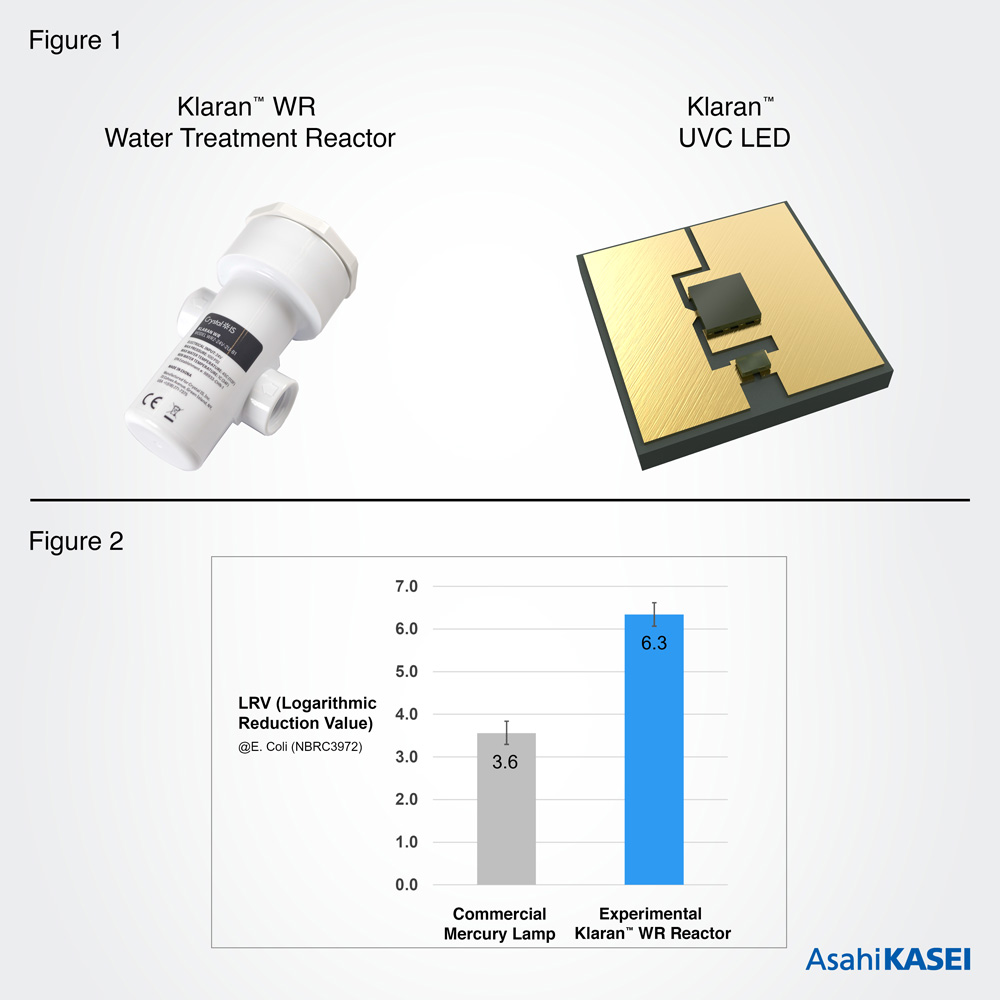News: LEDs
10 October 2022
Asahi Kasei demos Crystal IS UVC LED-based water disinfection
Tokyo-based Asahi Kasei and its subsidiary Crystal IS Inc of Green Island, NY, USA, which makes proprietary ultraviolet light-emitting diodes (UVC LEDs), have concluded in a bacterial performance test that an experimental Klaran WR water treatment reactor demonstrated over 75% higher performance than a traditional low pressure mercury lamp system using an equivalent power consumption level.
Klaran WR is an inline point-of-use (PoU) water treatment reactor (see Figure 1, left) that combines Crystal IS’ UVC LEDs based on aluminium nitride (AlN) substrates (Figure 1, right) with Asahi Kasei’s R&D capability in the design and application of optics and fluid dynamics.

Picture: Klaran WR is an inline point-of-use (PoU) water treatment reactor (Figure 1, left) which combines Crystal IS’ UVC LEDs based on aluminium nitride (AlN) substrates (Figure 1, right), with Asahi Kasei’s R&D capability in the design and application of optics and fluid-dynamics. Figure 2 shows the disinfection performance of the mercury lamp system (left) and the experimental Klaran WR (right).
While conventional UV water treatment systems have used mercury lamps as a light source, nations around the world have adopted stricter regulations after the Minamata Convention on Mercury became effective in 2017, due to the hazards that mercury poses to health and the environment. UVC LEDs have been developed as a mercury-free light source featuring small size, light weight and flexibility in design. A key milestone speeding the transition to this light source is demonstrating that the disinfection performance, power efficiency and value of LED technology can fully meet or exceed the incumbent mercury lamp.
While it is widely understood and accepted that UVC LED’s instant on-off capability offers a significant advantage and better alignment with actual consumer use than an ‘always on’ mercury lamp system, a question remained whether an equivalent-powered LED system could demonstrate equivalent disinfection performance as a low-pressure mercury lamp system. The experimental Klaran WR reactor was developed to demonstrate that UVC LEDs can achieve this.
A standard Klaran WR was enhanced and modified to operate with the same power consumption level (6W) as a comparable mercury lamp system. Both systems were tested using water at a flow rate of 8 liters per minute (2.1 gallons per minute), with a UV transmittance of 97% at 265nm and dosed with the addition of about 106CFU/mL of E. coli (a common gram-negative, facultative anaerobic, rod-shaped bacteria) for testing. As there is no established testing method for this type of comparison, Asahi Kasei devised the testing method and contracted an independent laboratory to perform the evaluation. Water quality samples recorded after 2 minutes steady operation with both systems were compared (Figure 2), demonstrating how the Klaran WR had over 2 LRV (logarithmic reduction value) better performance than the mercury lamp system, i.e. the Klaran WR system reduced E. Coli in the water to 1/100 of the level of the water disinfected by the mercury lamp system.
Asahi Kasei believes that, by replacing mercury lamps in water treatment systems with Crystal IS UVC LEDs, it can contribute to the realization of a mercury-free world and meet the global need for energy efficiency and safer water. In addition to water treatment systems, Crystal IS aims to apply the advantages of UVC LEDs to expand their application to surface and air disinfection.
Asahi Kasei and Nara Medical University confirm 226nm UVC LED efficacy against SARS-CoV-2
Crystal IS and Boston Uni demo Klaran UVC LEDs’ effective wavelength for inactivating SARS-CoV-2









